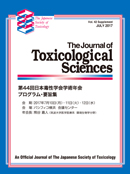The 47th Annual Meeting of the Japanese Society of Toxicology
Displaying 51-100 of 469 articles from this issue
Symposium 10
-
Session ID: S10-3
Published: 2020
Released on J-STAGE: September 09, 2020
Download PDF (181K) -
Session ID: S10-4
Published: 2020
Released on J-STAGE: September 09, 2020
Download PDF (158K)
Symposium 11
-
Session ID: S11-1
Published: 2020
Released on J-STAGE: September 09, 2020
Download PDF (183K) -
Session ID: S11-2
Published: 2020
Released on J-STAGE: September 09, 2020
Download PDF (191K) -
Session ID: S11-3
Published: 2020
Released on J-STAGE: September 09, 2020
Download PDF (194K) -
Session ID: S11-4
Published: 2020
Released on J-STAGE: September 09, 2020
Download PDF (171K)
Symposium 12
-
Session ID: S12-1
Published: 2020
Released on J-STAGE: September 09, 2020
Download PDF (169K) -
Session ID: S12-2
Published: 2020
Released on J-STAGE: September 09, 2020
Download PDF (179K) -
Session ID: S12-3
Published: 2020
Released on J-STAGE: September 09, 2020
Download PDF (136K)
Symposium 13
-
Session ID: S13-1
Published: 2020
Released on J-STAGE: September 09, 2020
Download PDF (146K) -
Session ID: S13-2
Published: 2020
Released on J-STAGE: September 09, 2020
Download PDF (192K) -
Session ID: S13-3
Published: 2020
Released on J-STAGE: September 09, 2020
Download PDF (150K) -
Session ID: S13-4
Published: 2020
Released on J-STAGE: September 09, 2020
Download PDF (145K)
Symposium 14
-
Session ID: S14-1
Published: 2020
Released on J-STAGE: September 09, 2020
Download PDF (153K) -
Session ID: S14-2
Published: 2020
Released on J-STAGE: September 09, 2020
Download PDF (115K) -
Session ID: S14-3
Published: 2020
Released on J-STAGE: September 09, 2020
Download PDF (126K) -
Session ID: S14-4
Published: 2020
Released on J-STAGE: September 09, 2020
Download PDF (134K)
Symposium 15
-
Session ID: S15-1
Published: 2020
Released on J-STAGE: September 09, 2020
Download PDF (168K) -
Session ID: S15-2
Published: 2020
Released on J-STAGE: September 09, 2020
Download PDF (179K)
Symposium 16
-
Session ID: S16-1
Published: 2020
Released on J-STAGE: September 09, 2020
Download PDF (207K) -
Session ID: S16-2
Published: 2020
Released on J-STAGE: September 09, 2020
Download PDF (189K) -
Session ID: S16-3
Published: 2020
Released on J-STAGE: September 09, 2020
Download PDF (209K) -
Session ID: S16-4
Published: 2020
Released on J-STAGE: September 09, 2020
Download PDF (216K)
Symposium 17
-
Session ID: S17-1
Published: 2020
Released on J-STAGE: September 09, 2020
Download PDF (188K) -
Session ID: S17-2
Published: 2020
Released on J-STAGE: September 09, 2020
Download PDF (206K) -
Session ID: S17-3
Published: 2020
Released on J-STAGE: September 09, 2020
Download PDF (208K) -
Session ID: S17-4
Published: 2020
Released on J-STAGE: September 09, 2020
Download PDF (167K) -
Session ID: S17-5
Published: 2020
Released on J-STAGE: September 09, 2020
Download PDF (118K) -
Session ID: S17-6
Published: 2020
Released on J-STAGE: September 09, 2020
Download PDF (133K)
Symposium 18
-
Session ID: S18-1
Published: 2020
Released on J-STAGE: September 09, 2020
Download PDF (159K) -
Session ID: S18-2
Published: 2020
Released on J-STAGE: September 09, 2020
Download PDF (135K) -
Session ID: S18-3
Published: 2020
Released on J-STAGE: September 09, 2020
Download PDF (121K) -
Session ID: S18-4
Published: 2020
Released on J-STAGE: September 09, 2020
Download PDF (122K) -
Session ID: S18-5
Published: 2020
Released on J-STAGE: September 09, 2020
Download PDF (140K)
Symposium 19
-
Session ID: S19-1
Published: 2020
Released on J-STAGE: September 09, 2020
Download PDF (175K) -
Session ID: S19-2
Published: 2020
Released on J-STAGE: September 09, 2020
Download PDF (199K) -
Session ID: S19-3
Published: 2020
Released on J-STAGE: September 09, 2020
Download PDF (180K) -
Session ID: S19-4
Published: 2020
Released on J-STAGE: September 09, 2020
Download PDF (165K) -
Session ID: S19-5
Published: 2020
Released on J-STAGE: September 09, 2020
Download PDF (164K)
Symposium 20
-
Session ID: S20-1
Published: 2020
Released on J-STAGE: September 09, 2020
Download PDF (160K) -
Session ID: S20-2
Published: 2020
Released on J-STAGE: September 09, 2020
Download PDF (160K) -
Session ID: S20-3
Published: 2020
Released on J-STAGE: September 09, 2020
Download PDF (169K) -
Session ID: S20-4
Published: 2020
Released on J-STAGE: September 09, 2020
Download PDF (166K)
Symposium 21
-
Session ID: S21-1
Published: 2020
Released on J-STAGE: September 09, 2020
Download PDF (157K) -
Session ID: S21-2
Published: 2020
Released on J-STAGE: September 09, 2020
Download PDF (111K) -
Session ID: S21-3
Published: 2020
Released on J-STAGE: September 09, 2020
Download PDF (138K) -
Session ID: S21-4
Published: 2020
Released on J-STAGE: September 09, 2020
Download PDF (193K) -
Session ID: S21-5
Published: 2020
Released on J-STAGE: September 09, 2020
Download PDF (178K)
Symposium 22
-
Session ID: S22-1
Published: 2020
Released on J-STAGE: September 09, 2020
Download PDF (164K) -
Session ID: S22-2
Published: 2020
Released on J-STAGE: September 09, 2020
Download PDF (158K)
